
Theo van Doesburg: Renewal of Architecture
Brief summary of the principles that the De Stijl group adhered to both practically and theoretically between 1917-1924 in the Netherlands.
Source
Stavba, roč. III, 1924-25, s.23-26
Stavba, roč. III, 1924-25, s.23-26
Publisher
Petr Šmídek
06.12.2011 21:15
Petr Šmídek
06.12.2011 21:15
Theo van Doesburg
FORM. The foundation of healthy architectural development (and art in general) is to overcome the concept of form in the sense of a predetermined type. Instead of using past stylistic types as templates and thus also instead of imitating and reproducing these past styles, the problem of architecture must be posed entirely anew.
New architecture is elementary, i.e.: derived solely from the elements of construction in the broadest sense. These elements such as: function, area, mass, time, light, space, color, material, and so forth are simultaneously the elements of creation.
New architecture is economical, meaning: it organizes its elementary means as factually and sparingly as possible, without violating these means and materials.
New architecture is functional, i.e.: it evolves from precisely identified practical needs, which are specified in a clear plan.
New architecture is formless. (It is not formalist.) Therefore, it refuses to accept any a priori formal schema as aesthetic, does not strive for any specific shapes (as bakers and confectioners do), but creates functional spaces dictated by the practical requirements of living. In contrast to the styles of the past, modern architecture does not recognize any self-contained type or fundamental space.
The development of functional spaces is strictly determined by right-angled surfaces, which have no individual shape of their own and for themselves, as they can be thought of as infinitely enlarged, even though they are delineated from one another. An axial system arises, in which various points correspond with similar points in universal open space. This leads to the conclusion that surfaces are in immediate tension with open space (exterior).
New architecture has made the concept of monumentality independent of small or large spaces. It has shown that everything is determined by the relationship of one thing to another.
New architecture recognizes not a single passive moment. It has overcome the gap. A window as an opening has an active significance in relation to the “closure” of the surface. Nowhere does a gap or void arise; everything is determined by its contrast. (See construction, where architectural elements, surfaces, lines, volumes are freely drawn in three-dimensional spatial relationships.) (p. 26.)
FLOOR PLAN. New architecture has broken the wall and there denied the dualistic distinction between interior and exterior. It no longer has load-bearing walls; walls merely delineate space; in their place come support points.
Thus, a new open floor plan system emerges, completely different from the classical one, in which external and internal spaces penetrate one another.
New architecture is open. The whole is a space that is differentiated according to practical needs. This division occurs in the interior by separating surfaces and in the exterior by protective walls. The first walls that separate various functional spaces can be movable, i.e., these surfaces (previously internal walls) can be arranged differently on movable tracks or panels (doors must be positioned in relation to this possibility). In the next stage of architectural development, the floor plan may completely disappear. A spatial composition projected into two dimensions will be replaced by an exact calculation of the construction that translates all forces and tensions into several most advantageous support points (in this regard, the initiatives are the experiments of architect Mies van der Rohe). These calculations will no longer suffice with Euclidean mathematics but will be easily reached with non-Euclidean four-dimensionality.
SPACE AND TIME. While old architecture only counts on space as the accent of creation, new architecture also incorporates the moment of duration. The unity of time and space gives the architectural creation a completely new and more perfect expression.
New architecture is anti-cubic, i.e.: it does not attempt to enclose functional spatial cells (or even surfaces and volumes) in a cube, but directs these spatial cells from the center to the periphery of the cube, thereby
SYMMETRY AND REPETITION. New architecture has abandoned monotonous repetition, such as the equality of two halves, mirror images, symmetry. It knows no temporal repetitions, but a kinetic sequence of various types and norms. The complex is just as much a whole as one house. The same laws apply to the complex as to the city. Against symmetry, new architecture presents as a new task balancing unequal particles, that is particles that are different in their functional characteristics, differences in location, volume, weight, and surface proportions. The equivalence of these particles is preserved through balance, harmonious proportions, but not through the similarity of two halves. By completely denying the axis of symmetry, new architecture has equalized: “front” and “back,” “left” and “right,” and almost “up” and “down.” Neither dominates the other.
In contrast to the frontality given by a statistical view of life, new architecture develops the plastic richness of multifaceted time-space interactions.
COLOR. New architecture has brought painting, as a particular imaginary expression of harmony, either secondarily by means of representational compositions or primarily through elementary color surface compositions to the fore. New architecture embraces color elementarily, as an expressive element of time-space relationships. Without color, these relationships would not be living experiences; they would remain invisible.
The balance of architectural relationships can only be revealed through color. Organizing colors into harmonious unity (not merely on a simple two-dimensional surface), but in the new realm of time-space is the task of the modern painter.
In a further stage of development, color may be replaced by denatured materials that encompass colors (red, blue, yellow, black, white, gray) in their chemical composition (the task of chemistry).
New architecture is anti-decorative. Color (as colorblind architects often try to understand it) is not an ornamental decorative element at all, but an organic, constitutive, expressive element of architecture, as essential as glass, iron, etc.
ARCHITECTURE AS A SYNTHESES OF NEW CREATION. Construction is a component of new architecture. Architecture is a synthesis of all arts in their elementary expressions. New architecture demands that the artist think four-dimensionally, and the architect (including painter and sculptor) is obliged to construct in the time-space area, as new architecture does not require any secondary artistic product (in the form of a painting or sculpture), but simply the task is for the artist to build a harmonious whole with essential means.
New architecture has no place for private sentiments; it demands a comprehensive expression, that is: maximum expression and minimum means without detriment to functionality.
New architecture is elementary, i.e.: derived solely from the elements of construction in the broadest sense. These elements such as: function, area, mass, time, light, space, color, material, and so forth are simultaneously the elements of creation.
New architecture is economical, meaning: it organizes its elementary means as factually and sparingly as possible, without violating these means and materials.
New architecture is functional, i.e.: it evolves from precisely identified practical needs, which are specified in a clear plan.
New architecture is formless. (It is not formalist.) Therefore, it refuses to accept any a priori formal schema as aesthetic, does not strive for any specific shapes (as bakers and confectioners do), but creates functional spaces dictated by the practical requirements of living. In contrast to the styles of the past, modern architecture does not recognize any self-contained type or fundamental space.
The development of functional spaces is strictly determined by right-angled surfaces, which have no individual shape of their own and for themselves, as they can be thought of as infinitely enlarged, even though they are delineated from one another. An axial system arises, in which various points correspond with similar points in universal open space. This leads to the conclusion that surfaces are in immediate tension with open space (exterior).
New architecture has made the concept of monumentality independent of small or large spaces. It has shown that everything is determined by the relationship of one thing to another.
New architecture recognizes not a single passive moment. It has overcome the gap. A window as an opening has an active significance in relation to the “closure” of the surface. Nowhere does a gap or void arise; everything is determined by its contrast. (See construction, where architectural elements, surfaces, lines, volumes are freely drawn in three-dimensional spatial relationships.) (p. 26.)
FLOOR PLAN. New architecture has broken the wall and there denied the dualistic distinction between interior and exterior. It no longer has load-bearing walls; walls merely delineate space; in their place come support points.
Thus, a new open floor plan system emerges, completely different from the classical one, in which external and internal spaces penetrate one another.
New architecture is open. The whole is a space that is differentiated according to practical needs. This division occurs in the interior by separating surfaces and in the exterior by protective walls. The first walls that separate various functional spaces can be movable, i.e., these surfaces (previously internal walls) can be arranged differently on movable tracks or panels (doors must be positioned in relation to this possibility). In the next stage of architectural development, the floor plan may completely disappear. A spatial composition projected into two dimensions will be replaced by an exact calculation of the construction that translates all forces and tensions into several most advantageous support points (in this regard, the initiatives are the experiments of architect Mies van der Rohe). These calculations will no longer suffice with Euclidean mathematics but will be easily reached with non-Euclidean four-dimensionality.
SPACE AND TIME. While old architecture only counts on space as the accent of creation, new architecture also incorporates the moment of duration. The unity of time and space gives the architectural creation a completely new and more perfect expression.
New architecture is anti-cubic, i.e.: it does not attempt to enclose functional spatial cells (or even surfaces and volumes) in a cube, but directs these spatial cells from the center to the periphery of the cube, thereby
(height + width + depth) x time
achieving a new plastic expression in open space. Thus, architecture, as long as new technical advancements allow, achieves an appearance more or less suspended compared to natural heaviness.SYMMETRY AND REPETITION. New architecture has abandoned monotonous repetition, such as the equality of two halves, mirror images, symmetry. It knows no temporal repetitions, but a kinetic sequence of various types and norms. The complex is just as much a whole as one house. The same laws apply to the complex as to the city. Against symmetry, new architecture presents as a new task balancing unequal particles, that is particles that are different in their functional characteristics, differences in location, volume, weight, and surface proportions. The equivalence of these particles is preserved through balance, harmonious proportions, but not through the similarity of two halves. By completely denying the axis of symmetry, new architecture has equalized: “front” and “back,” “left” and “right,” and almost “up” and “down.” Neither dominates the other.
In contrast to the frontality given by a statistical view of life, new architecture develops the plastic richness of multifaceted time-space interactions.
COLOR. New architecture has brought painting, as a particular imaginary expression of harmony, either secondarily by means of representational compositions or primarily through elementary color surface compositions to the fore. New architecture embraces color elementarily, as an expressive element of time-space relationships. Without color, these relationships would not be living experiences; they would remain invisible.
The balance of architectural relationships can only be revealed through color. Organizing colors into harmonious unity (not merely on a simple two-dimensional surface), but in the new realm of time-space is the task of the modern painter.
In a further stage of development, color may be replaced by denatured materials that encompass colors (red, blue, yellow, black, white, gray) in their chemical composition (the task of chemistry).
New architecture is anti-decorative. Color (as colorblind architects often try to understand it) is not an ornamental decorative element at all, but an organic, constitutive, expressive element of architecture, as essential as glass, iron, etc.
ARCHITECTURE AS A SYNTHESES OF NEW CREATION. Construction is a component of new architecture. Architecture is a synthesis of all arts in their elementary expressions. New architecture demands that the artist think four-dimensionally, and the architect (including painter and sculptor) is obliged to construct in the time-space area, as new architecture does not require any secondary artistic product (in the form of a painting or sculpture), but simply the task is for the artist to build a harmonious whole with essential means.
New architecture has no place for private sentiments; it demands a comprehensive expression, that is: maximum expression and minimum means without detriment to functionality.
* * *
Since 1916, these fundamental principles, first developed by Piet Mondrian and the author of this article, and which were explored in architectural practice by architects such as: Rob. van' T. Hoff, Wils, Oud, have become the living principles of the magazine “De Stijl”, which has a significant credit for the fact that so many good buildings have emerged in the Netherlands. With this processing, which has excluded many classical survivals, we are enabled to further advance the problem of architecture. Those who have drawn consequences from this, Rietveld, Mies van der Rohe, van Leuseden, Eesteren, the author of this article and new students, demonstrated last year with their exhibition at the gallery “L'effort moderne” (Léonce Rosenberg) in Paris that shared thinking allows a collective style.(Paris, May 1924.)
Written for “Stavba”. Translated by K. TeigeThe English translation is powered by AI tool. Switch to Czech to view the original text source.
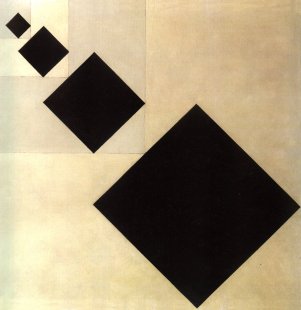
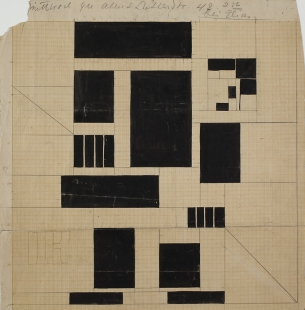
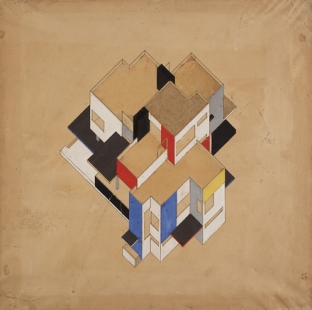

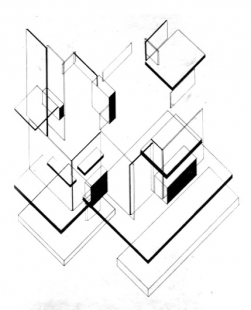
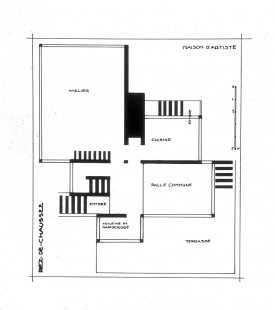
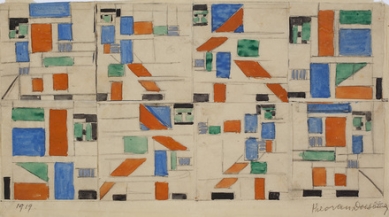
0 comments
add comment











